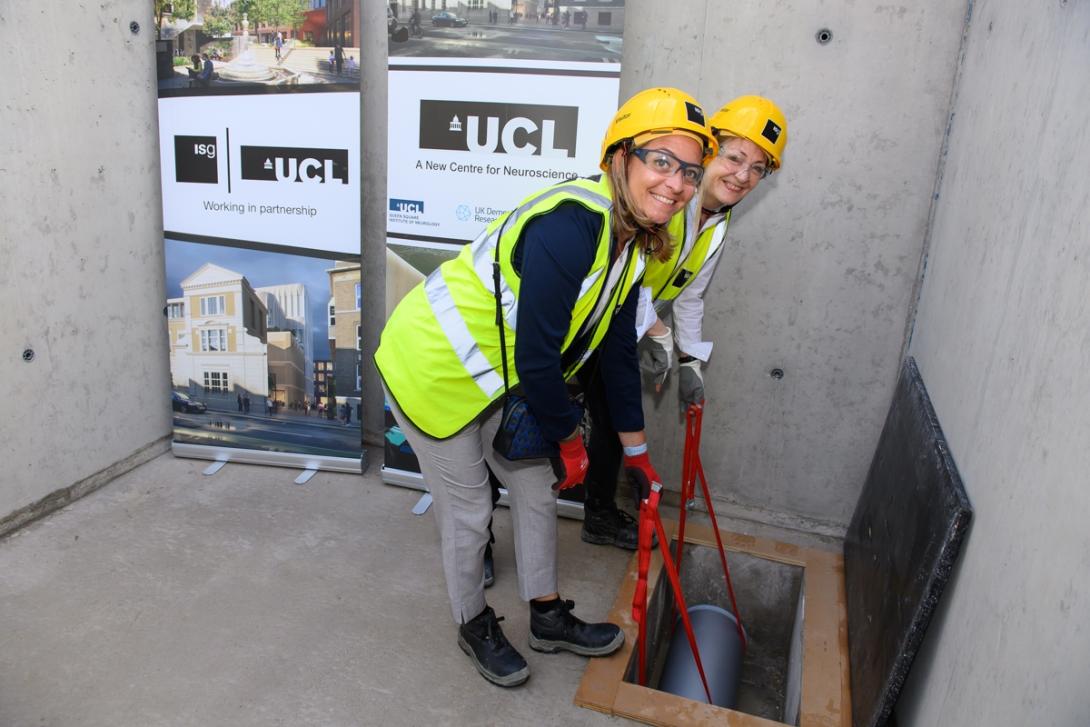An Iceland plastic carrier bag, a Covid-19 vaccine vial and a piece of stainless steel have been buried in a time capsule of a new world-class centre for neuroscience at UCL, and the future home of the UK DRI hub, currently in construction on Grays Inn Road, London. The capsule was placed in the building’s foundations today (Thursday 19 May) as part of Dementia Action Week.
UCL is already one of the world's largest, most productive and highest-impact neuroscience centres and the pioneering new building, due to open in 2024, will accelerate the discovery of treatments for neurological conditions, including dementia, of which there is still no known cure.
Expanding the existing facilities at Queen Square Institute of Neurology will create a dual hub for neurological science and house the UK DRI at UCL and HQ team; a large proportion of UCL Queen Square Institute of Neurology; and an outpatient facility for the UCLH National Hospital for Neurology and Neurosurgery, allowing clinicians and researchers to work closer than ever before with people with neurological disorders, their doctors and researchers.
The time capsule, due to be opened in 2049 – the building’s silver jubilee - includes a range of objects that tell the story of the centre’s foundation and preserve its memories for years to come, from its inception, obtaining the Eastman Dental Hospital site in 2017, approval of the planning application in 2019 and breaking ground in 2021 – navigating the Covid-19 pandemic along the way.
The scheduled opening of the time capsule for the new building's silver jubilee

Queen Square Institute of Neurology Manager, Dr Hélène Crutzen and local resident Marianne Jacobs-Lim bury the time capsule at 256 Grays Inn Road
A plastic bag was included to represent the total of £20 million donated by supermarkets to create the new facility, raised from the proceeds of the 5p carrier bag charge. Iceland Foods Founder and Executive Chairman Sir Malcolm Walker founded the Dementia Research Retail Partnership - a group of nine UK retailers who committed to support dementia research at UCL.
The Covid-19 vaccine, alongside the genomic sequence for the virus represents the work that both scientists at UCL and clinicians at UCLH have undertaken during the pandemic, while the piece of stainless steel symbolises the joint UCLH and UCL MRI facility, which will bring up to six new MRI scanners into operation. During construction, standard iron girders could not be used in this space, due to the powerful magnets involved.
Other items in the time capsule include a giant sunflower head, cast in black-pigmented Jesmonite by artist Annie Cattrell. The sunflower was gifted to the project’s site artist by the neighbouring Calthorpe Community Garden, who had planted and grown the flower during lockdown.
Site artist Freya Gabie has included drawings of the work site’s surface, pupils at nearby Christopher Hatton primary school imagined what scientists would have discovered in 25 years’ time and the capsule includes a selection of commonly used lab items in 2022 and research image photographs from early career researchers and students.
Prof Bart De Strooper and Dr Adrian Ivinson, UK DRI Directors, said:
“Here in 2022, it is a pretty challenging time globally and we have no treatments for Alzheimer’s disease. But for those of us who believe in the power of science to improve health, there is wonderful anticipation for the building within which this time capsule is buried.
"Thinking ahead to its reopening in 2049, did we pull it off? Do patients at risk of dementia have hope again? Is work ongoing with the expectation that one day soon dementia can be prevented? Are the researchers full of the passion, optimism and energy that we were feeling as we moved into this splendid new building? We hope so!”
Prof Alan Thompson, Dean, Faculty of UCL Brain Sciences said:
“The new UCL building at 256 Grays Inn Road has been an ambitious project, long in the making and to see what it has helped to achieve in 25 years is tantalising.
“UCL is a global leader in pioneering research into neurological conditions that cause disabling and distressing symptoms such as immobility and dementia and it can be a challenge to link researchers with clinicians, patients, industry, and students. This new purpose-built centre of excellence will enable that collaboration between these key groups to take place and, as a consequence, new treatments to be developed and tested.
“Our goal is to translate discoveries into treatments and have a real impact on patients with disabling neurological conditions and those affected by them. I am sure that in 25 years we will have taken considerable steps to translating that goal into a reality.”
Find out more about plans for the state-of-the-art facility here, and sign up the the UK DRI monthly newsletter to stay up to date with all the latest news from the Institute here.
Article published:19 May 2022
